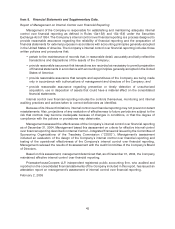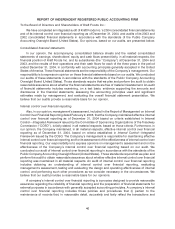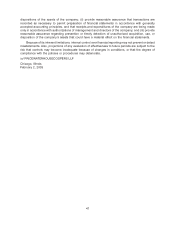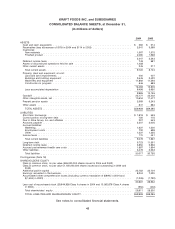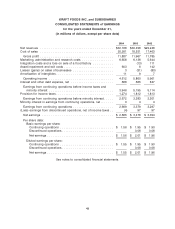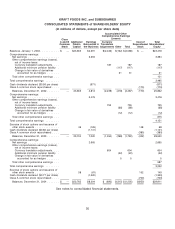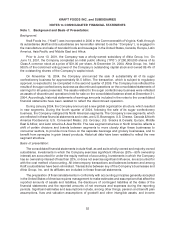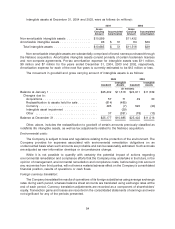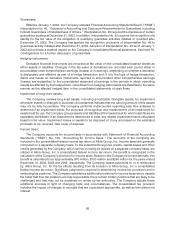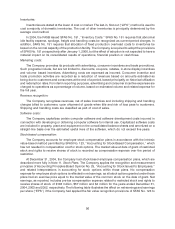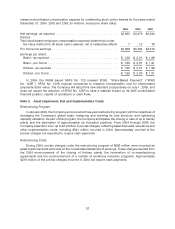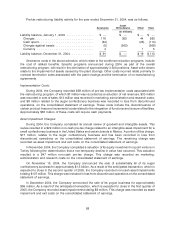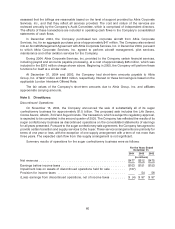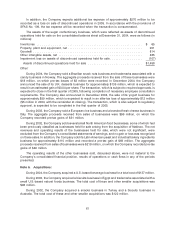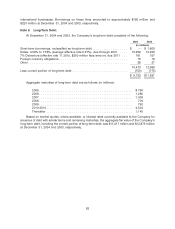Kraft 2004 Annual Report Download - page 56
Download and view the complete annual report
Please find page 56 of the 2004 Kraft annual report below. You can navigate through the pages in the report by either clicking on the pages listed below, or by using the keyword search tool below to find specific information within the annual report.Guarantees:
Effective January 1, 2003, the Company adopted Financial Accounting Standards Board (‘‘FASB’’)
Interpretation No. 45, ‘‘Guarantor’s Accounting and Disclosure Requirements for Guarantees, Including
Indirect Guarantees of Indebtedness of Others.’’ Interpretation No. 45 required the disclosure of certain
guarantees existing at December 31, 2002. In addition, Interpretation No. 45 requires the recognition of a
liability for the fair value of the obligation of qualifying guarantee activities initiated or modified after
December 31, 2002. The Company has applied the recognition provisions of Interpretation No. 45 to
guarantee activity initiated after December 31, 2002. Adoption of Interpretation No. 45 as of January 1,
2003 did not have a material impact on the Company’s consolidated financial statements. See Note 18.
Contingencies for a further discussion of guarantees.
Hedging instruments:
Derivative financial instruments are recorded at fair value on the consolidated balance sheets as
either assets or liabilities. Changes in the fair value of derivatives are recorded each period either in
accumulated other comprehensive earnings (losses) or in earnings, depending on whether a derivative
is designated and effective as part of a hedge transaction and, if it is, the type of hedge transaction.
Gains and losses on derivative instruments reported in accumulated other comprehensive earnings
(losses) are reclassified to the consolidated statement of earnings in the periods in which operating
results are affected by the hedged item. Cash flows from hedging instruments are classified in the same
manner as the affected hedged item in the consolidated statements of cash flows.
Impairment of long-lived assets:
The Company reviews long-lived assets, including amortizable intangible assets, for impairment
whenever events or changes in business circumstances indicate that the carrying amount of the assets
may not be fully recoverable. The Company performs undiscounted operating cash flow analyses to
determine if an impairment exists. For purposes of recognition and measurement of an impairment for
assets held for use, the Company groups assets and liabilities at the lowest level for which cash flows are
separately identifiable. If an impairment is determined to exist, any related impairment loss is calculated
based on fair value. Impairment losses on assets to be disposed of, if any, are based on the estimated
proceeds to be received, less costs of disposal.
Income taxes:
The Company accounts for income taxes in accordance with Statement of Financial Accounting
Standards (‘‘SFAS’’) No. 109, ‘‘Accounting for Income Taxes.’’ The accounts of the Company are
included in the consolidated federal income tax return of Altria Group, Inc. Income taxes are generally
computed on a separate company basis. To the extent that foreign tax credits, capital losses and other
credits generated by the Company, which cannot currently be utilized on a separate company basis, are
utilized in Altria Group, Inc.’s consolidated federal income tax return, the benefit is recognized in the
calculation of the Company’s provision for income taxes. Based on the Company’s current estimate, this
benefit is calculated to be approximately $70 million, $100 million and $240 million for the years ended
December 31, 2004, 2003 and 2002, respectively. The Company makes payments to, or is reimbursed
by, Altria Group, Inc. for the tax effects resulting from its inclusion in Altria Group, Inc.’s consolidated
federal income tax return. Significant judgment is required in determining income tax provisions and in
evaluating tax positions. The Company establishes additional provisions for income taxes when, despite
the belief that their tax positions are fully supportable, there remain certain positions that are likely to be
challenged and that may not be sustained on review by tax authorities. The Company adjusts these
additional accruals in light of changing facts and circumstances. The consolidated tax provision
includes the impact of changes to accruals that are considered appropriate, as well as the related net
interest.
55


